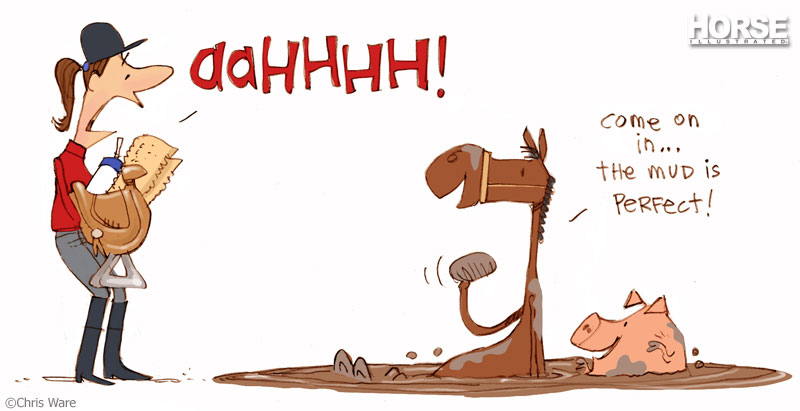
Horses often won’t choose to move to shelter or higher ground, even if we think it’s in their own best interest. Illustration by Chris Ware
Q: When it rains, it gets really wet and muddy in my horse’s corral, right where he wants to stand. How can I improve drainage? Or how can I convince my horse to move to higher ground where it’s dry?
A: One of the most puzzling and frustrating aspects of horsekeeping is accepting that horses are going to choose to stand and hang out where they want. We can wring our hands and fret all we want, but if our horses decide it’s preferable to stand where they can be near other horses, or where they can see our backdoor or the comings and goings from the feed room, then we’re unlikely to convince them to move elsewhere, even if it’s for their own good. So one option is to move the higher ground—and perhaps a shelter—to the area where your horse spends most of his time. A shelter, whether it’s a simple free-standing roof supported by poles or a three-sided shed, will help skirt rain and snow from that immediate area and also make a cozy home for your horse.
Then you can construct a pad that will elevate your horse’s chosen spot above the flood plain of the rest of the corral. You may need to haul in several yards of sand, screened fill dirt or DG (decomposed granite) and compact it to form the pad. It’s really not that difficult; it just requires some planning and muscle strength to heft the earth around. This tactic is more permanent than using bags of commercially available hyper-absorbent materials. They work great, especially for short bouts of rain, but they aren’t a long-term fix.
Finally, depending on the lay of the surrounding property, you might also consider adding a catch basin that will escort the run-off out of the corral. This is a sort of box set into the ground, covered with a grate, that’s placed at a low point just outside the corral. Inside the box is a pipe that drains into an even lower area, like a creek bed or downhill slope. Excess water will naturally flow into the catch basin and through the pipe and out to the designated area. Though this may all sound like a major construction project, it really isn’t. All the supplies can be found at your local home improvement center, which many horse owners frequent about as often as the feed store.
–Cindy Hale






Odd problem
We have the same problem, and there is NO easy way to fix it. We can not afford, pipes and this or that, we just try to deal with it by feeding in the higher spots, and keeping it clean out the best way we can.
Good artical
It is a constant mud battle in the PNW. This is what I do
Fall/Winter/Spring:
-Take pictures of drainage/mud issues (because I definitely forget by summer) while it is wet out
Summer:
-Use tractor to grade/create burms and swales around and in paddocks to direct water
-Fill in low spots
We also use expanding plastic panels from http://www.lighthoof.com in the worst areas, which is usually in the front of the paddocks where the horses wait to get turned in.